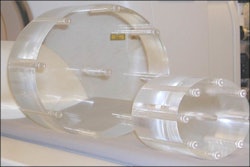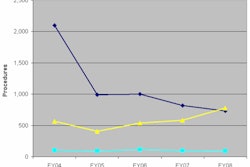CT use has continued to rise for young patients who visit the emergency department (ED) for nontraumatic abdominal pain, according to a new study published online April 24 in Radiology.
The odds of a child's receiving an emergency abdominal CT scan increased every year between 1999 and 2007, according to researchers at Children's Hospital Boston, although growth was slower in children's hospitals.
The results came despite a lack of growth in patient admissions over the study period, and there was no concomitant increase in ultrasound use, according to lead author Dr. Anastasia Hryhorczuk and colleagues.
"Our study also shows that the choice and frequency of use of imaging studies in children with abdominal pain who present to the ED vary widely across regions of the U.S. and appear to be influenced by demographic factors including sex, age, race, and insurance status," the authors wrote (Radiology, April 24, 2012).
Nontraumatic abdominal pain is a common source of pediatric visits to the emergency room -- with suspicion of appendicitis a key driver of CT scans. The scans are fast and usually accurate, but they expose young patients to ionizing radiation and hence the risk of carcinogenesis years later.
Radiation concerns have led many institutions to emphasize ultrasound as part of a stepwise evaluation of possible pediatric appendicitis that begins with ultrasound and proceeds to CT only if ultrasound findings are negative or equivocal. Although this approach has been widely adopted in pediatric settings, the degree of adoption in the broader healthcare setting is unclear, as is the question of whether ultrasound use has increased along with that of CT.
The new study aimed to answer these questions by assessing national trends in nontraumatic emergency abdominal scans.
For data, the researchers looked to the National Hospital Ambulatory Medical Care Survey (NHAMCS), an annual government-administered survey of U.S. emergency departments that is used to outline the care provided in the emergency setting. The survey data include the type of hospital and the indication for abdominal pain scans performed in patients 20 years and younger.
A total of 4,972 emergency department visits (out of 16.9 million total visits) were for nontraumatic abdominal pain. Patients were predominantly adolescent (55.4%), female (66.3%), and white (68.7%), and 83.7% lived in an urban setting, the authors wrote. Private insurance was used by 40.6% of patients, and 36.4% had Medicare or Medicaid.
Overall, among patients younger than 20 years, 8.5% underwent ultrasound and 9.5% underwent CT. But over the course of the study, CT use increased from 2% (95% confidence interval [CI]: 1%-6%) in 1999 to 16% (95% CI: 13%-21%) in 2007 (p < 0.01 for trend), while ultrasound use remained flat (p = 0.27 for trend).
Of the 221 patients who were ultimately diagnosed with appendicitis, 11% had ultrasound, 39% CT, and just 3% had both exams.
A multivariate model for CT use showed increased odds of having a CT scan for teens, those with white parents, patients in the Midwest, those in urban settings, patients with private insurance, and patients who were admitted or transferred from other institutions.
Conversely, CT use was reduced in patients who were paying out of pocket for their medical care or who had alternative nonprivate forms of insurance (adjusted odds ratio, 0.82).
However, the odds of undergoing CT were significantly lower among patients who presented to a pediatric-focused emergency department (adjusted odds ratio, 0.72; 95% CI: 0.58-0.90).
"In a pediatric setting, clinicians may have skills for evaluating patients that favor management without imaging, lowering CT usage," Hryhorczuk said in a statement accompanying release of the study.
In addition, she said, CT scanners are readily available in hospitals, while access to ultrasound may be limited based on operator availability in some areas. The local legal climate also may play a role in the type of imaging exam administered, since appendicitis diagnoses are a source of lawsuits in the pediatric emergency setting.
Prior studies evaluating the effect of insurance status on the incidence of perforated appendicitis in all patients have shown that the risk of the condition is higher among patients who lack private insurance.
"Given that CT serves an important role in the imaging of complicated appendicitis and the evaluation of abscess formation, it is surprising that CT use is reduced in this population, for whom a higher rate of complicated appendicitis is expected," Hryhorczuk and colleagues wrote.
The use of CT "merits special attention as an important contributor to the overall radiation exposure in the pediatric population," considering the radiosensitivity of the solid organs and the sensitivity of the pediatric population to harm from ionizing radiation, they wrote.
The study was performed before initiation of the Image Gently and Image Wisely campaigns to reduce pediatric radiation exposure in 2008, the authors noted. Another limitation is that the study design does not provide for outcomes data.
"Focusing quality improvement initiatives on physicians at general hospitals may be an effective approach to decrease rates of CT imaging in pediatric patients," they concluded.




















